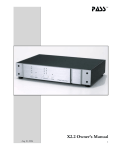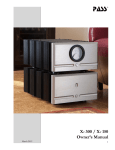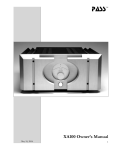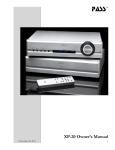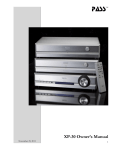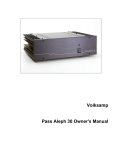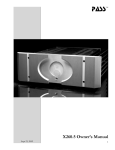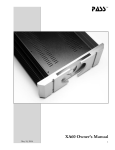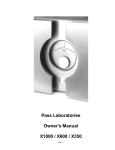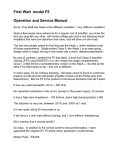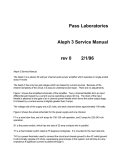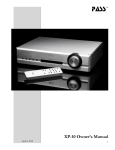Download Pass Labs X5 User's Manual
Transcript
pass TM X5 Owner’s Manual May 2006 Manual X5 18, Owner’s 1 Introduction The X5 five channel amplifier embodies the design technology and refinements of the larger “X” series amplifiers including extensions of the patented Supersymmetry circuit. The Supersymmetry circuit topology was granted a U.S. patent in 1994, and is the result of 19 years of effort by Nelson Pass. The amplifier uses highly matched components in a classically simple balanced Class A circuit. The amplifier contains only two simple stages: the first is a balanced single-ended Class A voltage gain stage. Its output drives a bank of high power Mosfets operated as voltage followers. These are inherently low distortion types of circuits, but their performance is improved when operated in balanced mode through cancellation. Distortion and noise identical to both halves of a balanced circuit will disappear at the output, and in a well-matched symmetric circuit, most of the distortion and noise is identical. Supersymmetry enhances this effect by providing a connection between the two halves of the balanced circuit that further perfects the match. Any distortion and noise not already identical to the two halves is made identical, and the result is improved cancellation at the output. Unlike feedback techniques where the goal is to correct for the distortion by feeding a gain stage an inversely distorted signal, Supersymmetry seeks merely to create perfect matching. Matched balanced power circuitry typically sees a distortion and noise reduction of about 90% (20 dB) through a balanced connection without any additional effort. The Supersymmetric circuit delivers another 90% reduction, so that the X series has about 1/100 of the distortion of a conventionally simple amplifier. Actually this ordinary distortion and noise can still be seen at the output of one half of the circuit, but since it is virtually identical on the other half, it goes away at the speaker terminals. This gives good measured performance, which because it is simple, also sounds excellent. Previously these kinds of simple Class A circuits have been popular for their sound quality in low power amplifiers, but have not found application at high power levels due to excessive distortion and low efficiency. Supersymmetry overcomes this barrier, delivering the sweetness, staging, and detail of very simple circuitry up to kilowatt power levels and beyond. X5 Owner’s Manual 2 The X Series amplifiers have the tremendous dynamic range (>150 dB) to do justice to the 24 bit recordings of the 21st Century. The simple but powerful circuitry moves easily from total silence to explosive transient and back to silence without a trace. It’s a spooky experience. So relax and enjoy your amplifier. Call us if you ever have a problem or question. Thank you for buying our product. Setup You can position the amplifier anywhere you want, but it requires ventilation. We do not recommend placing it in enclosed cabinets or small closets without means for air to circulate freely. The amplifier idles at about 200 watts. Let’s talk about power requirements. The amplifier draws about 2 amps (continuous rms) out of the wall during normal audio operation, and this reflects mostly the idle current that we run through the output stage. If you are driving a low impedance load, you will draw more than this, but this will not be typical. The X5 is provided with the more conventional AC line cord, which is rated at 15 amps. The circuit ground is attached to the chassis in the conventional manner. Under no circumstances should you defeat the ground connection of the power cord. For your safety, the chassis of the amplifier should be earth grounded. Looking at the rear panel you will see the AC power cord receptacle, a power switch, fuse holder, five pairs of output connectors, a pair of 5 way connectors for remote turn-on, five RCA input connectors and five XLR balanced input connectors. Make sure that the power switch is off (down). Plug the AC cord into the back of the amplifier, and then into the wall. Then turn the switch on (up). The lights in your house will blink when the power supply charges the capacitors. On the front panel, the “Standby” LED indicator should be glowing blue, indicating that the power is on. The “Power” LED should not be on. If the “Power” LED is on, don’t get excited, just use the front panel stand-by button to go to stand-by mode, with the “Standby” LED on and the “Power “ LED off. OK, so the amplifier is sitting there in stand-by mode with just the X5 Owner’s Manual 3 single blue LED lit. No speaker connected yet. You can go ahead and connect the source and speakers. The amplifier can be driven single-end or balanced, if driving the amplifier single-ended leave the supplied jumpers in place (between pins 1 & 3 on the XLR). Now that the source component is connected, make sure there is no signal coming from it, probably by turning the volume all the way down. With the speakers connected, push the front panel button to activate the amplifier. The “Power” LED will come on. You are ready to play music. Do everybody a favor and try not to have shorted output cables. It happens accidentally all the time, and the amplifier is designed to survive, but I wouldn’t bet the farm on it. Of course it’s always possible that something could go wrong. If so, don’t get excited, just relax. It’s really aggravating when something like this doesn’t work, we understand, but it will get fixed. We go to a lot of trouble to make products reliable, and the failure rate of our amplifiers is almost non-existent. This is small comfort to the few, but take it easy and give us a call if you have problems. People are interested in how long it takes for these amplifiers to break in. It takes about an hour for them to warm up, and this is where we adjust them first. Then we adjust them again and again over a couple of days, keeping the bias and offset in the sweet spot. Our environment is about 23 degrees Centigrade, room temperature, and the heat sinks will rise to about 22 degrees C. above that, for a heat sink temperature of 45 degrees C. In your setup the temperature may vary a bit due to line voltage and ventilation, but it is not a big deal. You should be able to put your hands on the heat sinks without discomfort. The amplifier has a thermal cutout that will disconnect AC power if the temperature exceeds 75 degrees Centigrade. This should never occur in real life. More things to know: You can remotely operate the stand-by mode by applying 12 volts DC to the single pair of 5 way connectors on the rear of the amplifier. The positive of the 12 volts DC goes to the red connector. This connection has an actual operating range X5 Owner’s Manual 4 of about 9 volts to 15 volts. This switching will override the front panel button, so if you want the button to operate, leave the rear connection open. So much for essential information. Speaker Interface The X5 is optimized for loads nominally rated at 4 ohms and above. You can run the amplifiers into a lower nominal impedance without difficulty, and we are not aware of a speaker on the market that presents unusual difficulty with these amplifiers. The X amplifiers do not care particularly about the reactivity of the load. Reactive loads typically will have slightly less distortion at a given voltage/current level than resistive loads, but will make the amplifier run a little hotter. The X circuit was designed to be quite happy driving electrostatic and other speakers, since it is unconditionally stable. When driving transformer-coupled loads directly, as in some electrostatic and ribbon designs, some attention must be paid to the DC character of the situation. If the transformer primary is being driven raw with no protection from DC and your source has DC voltage, or in cases where the small offset of the power amplifier is still too much, you may create distortion in the transformer and get less than optimal performance from it. Generally this is not the case with transformer coupled loudspeakers, but it does occasionally surface. In these cases, take special care that the source does not contain a differential DC component, and confirm the differential DC offset of the amplifier is sufficiently low. This is easily adjusted by a qualified technician armed with the service manual. Again, consult your dealer or call us. Interconnects and Speaker Cables We have a general recommendation about interconnects, which is that they should cost less than the amplifier. We have tried a lot of products and most of them work well, but as a practical matter we cannot make blanket recommendations. The amplifier is not sensitive to source interconnects. It is also not sensitive to radio frequency pickup, which allows some flexibility in choosing source interconnects without shields. We prefer speaker cables that are thick and short. Silver and copper are the preferred metals. If you find any cable made of gold, please send me a couple hundred feet. X5 Owner’s Manual 5 Fortunately the amplifier is not sensitive to the capacitive/inductive character of some of the specialty speaker cables, so feel free to experiment. We have found that about 90 per cent of bad sounding cables are really bad connections, and we recommend that special attention be paid to cleanliness of contact surfaces and tight fit. Speaker cables should be firmly tightened down at the speaker output terminals, but do not use a wrench. They will not withstand 100 foot-lbs of torque. Hand tightening without excessive force is plenty. Fun Hardware Facts The X5 has a power transformer, rated at 1000 watts, continuous duty. Under actual conditions in the amplifier the transformer will deliver about 1800 watts for short duration. All the transistors in the product are power Mosfets, actually Hexfets from International Rectifier and Harris. These are hyper-matched parts, with gate voltages matched to 0.5% and all devices taken from the same lot codes (made on the same wafer). The speed and noise critical gain devices in the front end, (that is to say the actual balanced pair of transistors) are ultra low noise and distortion matched JFETs having a low (.02 S) transconductance figure. The JFETs are made on the same substrate for prefect matching. The X5 has 40 output Mosfet power transistors in TO-3 plastic packages, again matched to 0.5% and drawn from the same lot codes for each type. The output stages can sustain transients of about 1,000 watts per channel, but are not allowed to dissipate more than half that, even into a dead short. So how long will this hardware last? It is my experience that, barring abuse or the odd failure of a component, the first things to go will be the power supply capacitors, and from experience, they will last 15 to 20 years. Fortunately they die gracefully and are easily replaced. After that, the longevity will depend on the number of operating thermal cycles, but I can say that I have had amplifiers operating in the field in excess of 20 years with no particular mortality except capacitors. The answer is, I don’t have good information beyond that. More to the point, I would suggest that you not worry about it. This is a conservatively built industrial design, not a tweaky tube circuit run on the brink. If it breaks, we will simply get it fixed, so sleep well. X5 Owner’s Manual 6 X5 Specifications All figures obtained after a 1 hour warmup, with regulated 120 VAC power line. See manual notes about AC power line regulation. Gain Freq. Response Power Output Maximum Output Voltage Maximum Output Current Input Impedance Damping factor Slew rate Output Noise Balanced CMRR DC offset Power Consumption Temperature Dimensions Shipping Weight 30 dB -0 dB at DC, -3 dB at 100 kHz 125 X 5 watts maximum @ 1% THD, 1 kHz, 8 ohms plus, minus 50 volts plus, minus 10 amps 22 kohm balanced 200 ref 8 ohms nominal plus, minus 50 V/uS 300 uV unweighted 20-20 kHz -85 dB @ 1 kHz (input common mode rejection ratio) < 100 mv 200 watts idle, 600 watts maximum 20 degrees C. above ambient typical 19 “ W x 7” H x 20” D 74 lbs. For more information please contact: Pass Laboratories Inc. P.O. Box 219, 24449 Foresthill Rd., Foresthill, CA 95631 Tel: 530.367.3690 Fax: 530.369.2193 www.passlabs.com © 2006, Pass Laboratories Inc. “Pass”, “pass”, “Pass Labs”, “Pass Laboratories”, Supersymmetery”, “Aleph”, and “Zen” and are all registered trademarks of Pass Laboratories, Inc., and all rights thereto are protected by law. X5 Owner’s Manual 7 Warranty Information Please check with the factory-authorized distributor in the country you are purchasing this product for specific warranty information. All Pass Laboratories products purchased from an authorized Pass Laboratories dealer in North America are covered by a transferable, limited 3-year warranty. This warrantee includes all parts and labor charges incurred at the repair facility in addition to return shipping to the domestic customer, exclusive of subsequent damages. Damage due to physical abuse is specifically not covered under this warranty. For this warranty to apply the customer is responsible for returning the product unmodified to the factory within the warranty period. The customer assumes all responsibility for shipping and insurance to the factory or a factory specified repair facility. The conditions and stipulations of this Pass Laboratories warranty only applies to units sold new in North America. Non-North America customers should consult with their original Pass Labs dealer or distributor for warrantee repair instruction prior to contacting the factory or shipping product for repair. Non-North American product must be returned to the country of origin for warrantee service. Foreign distributors are only required to offer warranty service on Pass Laboratories product that they have imported. Please note: Conditions of warranty service and customer rights for product purchased outside the United States may vary depending upon the distributor and local laws. Please check with your local distributor for specific rights and details. Any modifications to Pass Laboratories products that have not received written factory approval nullify all claims and void the warrantee. Should a modified product be returned to the factory for repair the owner will be required to pay all necessary charges for the repair in addition to those charges required to return the product to it’s original configuration. In the case of safety issues, no product shall be returned to the customer without those safety issues being corrected to the most recent accepted standards. Removal or alteration of original Pass Labs serial numbers voids the factory warranty. Product with altered or missing serial numbers will be suspected as counterfeit product. Pass Laboratories will not repair or in any way indemnify any counterfeit or cloned product. Pass Laboratories does not offer products in voltages intended for international markets either to authorized Pass Labs dealers or to third parties located in the United States or Canada. X5 Owner’s Manual 8 For your protection please read the following: Water and moisture: Electrical devices should not be used near water ( as per example, near a bathtub, washbasin, kitchen sink, laundry tub, wet basement or swimming pool ). Care should be taken such that objects do not have the opportunity to fall, and that liquid is never spilled onto or into the device enclosure through openings. Power Sources: An electrical device must be connected to a mains power source in strict accordance with the supplied product owner’s manual. Please verify that the AC mains voltage specified in the product manual matches those requirements indicated on the unit and the AC voltage provided to your location by the power company. Grounding: Adequate precautions should be taken so that the grounding provisions built into an electrical product are never defeated. Power Cords: Pass Laboratories provides a power supply cord that meets all legislated requirements for the market in which the product was originally sold. If you choose to substitute an after-market product we urge you to choose one that is fully safety rated by the necessary local authority. Power Cord Protection: Power supply cords should be routed so that they are not likely to be walked on, abraded, or pinched by items placed on or against them, paying particular attention to cords where they enter plugs or exit from a device. Never under any circumstance insert a cut or damaged power cord into a mains power socket. Power and Signal: Cables should never be connected / disconnected with equipment powered up. Failure to heed this warning may damage or destroy equipment. Ventilation: Power-amplifiers run hot, but you should be able to place your hands on them without discomfort. You must allow for this heat in installation, by providing for free air circulation around the product. Electronics should not be subjected to sources of excessive radiant heat. Excessive heat can shorten the life of the product and may cause the electronics to self-protect and shut down. Servicing: To reduce the risk of fire, electrical shock or other injuries, the user should not attempt to service the device beyond that which is described in the operating instructions. All other servicing must be referred to qualified service personnel. X5 Owner’s Manual 9









